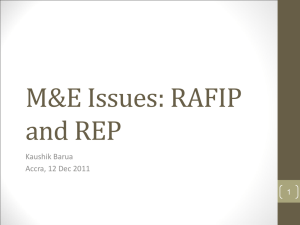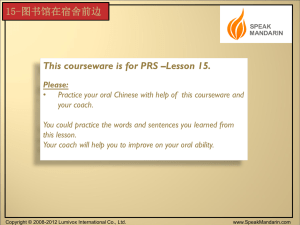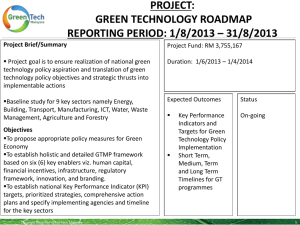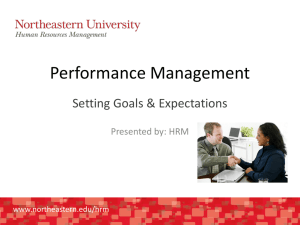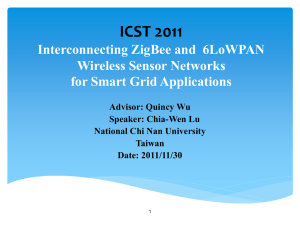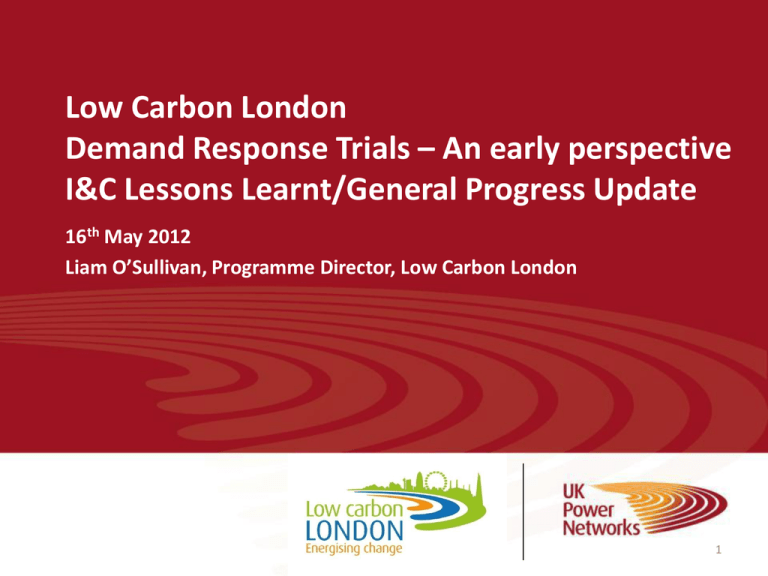
Low Carbon London
Demand Response Trials – An early perspective
I&C Lessons Learnt/General Progress Update
16th May 2012
Liam O’Sullivan, Programme Director, Low Carbon London
1
Agenda
•
•
•
•
•
•
•
•
•
2
Introduction, refresher and progress to date
Demand Response Trials
Carbon Impact
Typical I&C Customer Profile in London & Customer
Recruitment
Break
Conflicts and Synergies with other Demand Response
programmes
Baseline Methodology
Next steps – what the trials will look like
Closing remarks and emerging issues (including Q&A)
UK Power Networks
GENERATION
TRANSMISSION
DISTRIBUTION
SUPPLY
INDUSTRIAL
COMMERCIAL
RESIDENTIAL
3
UK Power Networks
Total
% of
Industry
End Customers
Millions
8.0
28%
Service Area
km²
29,165
12%
Underground
Network km
134,767
29%
Overhead
Network km
47,391
15%
Energy Distributed
TWh
89.4
28%
Peak Demand
MW
16,229
N/A
New Connections
130,768
35%
4
Low Carbon London - A learning journey
Learning how to create a smart low carbon city
A pioneering demonstration project,
trialling new technologies, commercial
innovation and design, operation and
network management strategies…
Smart Meters
Wind Twinning
Demand Side Management/I&C, Smart Appliances,
Demand Flexibility
Distributed Generation
Electric Vehicles
Heat Pumps
New Tools, Operational and Investment Practices
Learning Lab
Conclusions/Video
5
Progress: some key highlights
• A comprehensive project plan, solution design, trial hypothesis, test
cases and a fully mobilised delivery team – deliver the learning AND the
programme outcomes & objectives.
• A common demand response contract between three external
aggregators and UK Power Networks to enable sign up of customers to
reduce load at peak times on selected substations.
• c. 13MW’s signed up and further c.10MW as prospects…...
6
Demand Side Management (DSM)
Challenge:
Our low carbon electricity future is dependent on matching electricity
demand to available, intermittent supply
Our response:
Monitor how energy efficiency schemes and time-of-use tariffs affect
residential & SME (Small and Medium Enterprises) customer electricity demand
Assess the impact of these initiatives on the electricity network
Work with commercial aggregators to establish new demand response
(DR) contracts with industrial & commercial customers
Can demand response postpone/defer network reinforcement?
(When/How/Who/What/Where)
To what extent different demand side management initiatives can influence customers’
7
electricity consumption
Low Carbon London
Demand Response Trials – An early perspective
Summary
16th May 2012
Liam O’Sullivan, Programme Director, Low Carbon London
8
Method of triggering demand response:
2
UKPN Call
Aggregator
Aggregator contacts DSM
Partners
UKPN Operations
1
5
3
7
6
4
ODS
1
UK Power Networks operations are alerted to a peak in demand by an
Enmac alarm being raised.
8
UK Power Networks contacts the Aggregator, either by Phone or Email asking the
Aggregator to curtail demand at a particular substation. Each Aggregator will hold a
portfolio of customers that can influence demand at the substation.
The Aggregator sends a confirmation that they have received the notification and
3 takes action. The Aggregator will send a record of the Date and Time they confirmed
they would take action, and what level of curtailment will be provided.
2
I&C HH
Meter
D0003
DSM Partner
Reduces
Consumption
4 The Aggregator requests their portfolio of customers to take action.
5
UK Power Networks operations see the reduction in the SCADA measurements
recorded at the substation.
6
The Aggregator collects measurement data on a time interval basis on the
progress of the curtailment across all customers in the portfolio.
7
The Aggregator will send a file containing the measurement data at the customer level to the
Operational Data Store.
8
UK Power Networks obtains HH I&C metering data.
DSM Partner
SUMMARY - is it smart?
The current established ways of managing networks will quickly become
unsustainable.
We have built a strong foundation for innovation – as good if not better
than other DNO’s.
Any expertise developed through this process must be transferred and
embedded into the rest of the business, partners and professionals,
government, policy makers.
Commercial innovation, strategic partnerships and customer
engagement is crucial.
Must have embedded this philosophy into our business by RIIO-ED1.
Enable us to shape our business and enable us to become a top
performing company under the new regulatory framework (RIIO-ED1).
This is the beginning of a new era in the management of
electricity networks and asset management, future is here future is now!!
10
Any questions?
11
Low Carbon London Demand
Response Trial
An early perspective from our winter trial
Andrew Alabraba
16th May 2012
Demand Side Management (DSM)
• DSM has been traditionally seen as a means of reducing peak electricity
demand so that utilities can delay building further capacity
• When DSM is applied to the consumption of energy in general not just
electricity but fuels of all types
• This gives the rise to the concept of ‘smart grids’
“an electricity power system which can significantly integrate the actions
of all users connected to it – generators consumers, and those that do
both – in order to efficiently deliver sustainable, economic and secure
electricity supplies”
13
Smart Grid
Characteristics of a Smart Grid
Smart technologies to economically enhance the service quality, reliability,
security and safety of the electricity supply
Smart communications system to provide greater end-to-end visibility of
network conditions
Connections of low/zero carbon distributed generation (DG)
Smart power flow, storage, voltage and fault level management
Smart management of flexible/responsive demand to improve load factor,
minimise losses and create additional capacity headroom
Strategies to minimise the network loading impact of electrification of heat
and transport
14
Smart Grid
Characteristics of a Smart Grid
Smart technologies to economically enhance the service quality, reliability,
security and safety of the electricity supply
Smart communications system to provide greater end-to-end visibility of
network conditions
Connections of low/zero carbon distributed generation (DG)
Smart power flow, storage, voltage and fault level management
Smart management of flexible/responsive demand to improve load factor,
minimise losses and create additional capacity headroom
Strategies to minimise the network loading impact of electrification of heat
and transport
15
Demand Response
• Residential and Small Medium Enterprises (SME) consume approximately
50% of the electricity produced in the UK
• Increase in DG will mean that power flows will no longer be unidirectional
and predictable
• UK Power Networks understands that the estimated load growth due to
electrification of heat and transport we will need to be able to shift or
reduce demand locally at the point of need
16
DNO to DSO process
• A Distribution Network Operator (DNO) will continue to respond to load
growth in maximum or peak demand – it has no ability, desire or flexibility
to influence demand or generation
• A Distribution System Operator (DSO) will take advantage of the network
benefits of smart grid technology and have access to a portfolio of:
– Responsive demand
– Storage
– Controllable generation assets
• Inflexible to flexible , reactive to proavtive
17
Responsive Demand
• Flexible Demand such as electric vehicles, heat, cooling, white goods and
storage
• Dispatchable Resources such as network storage, demand response and
DG contracts
• Responsive demand can be obtained by managing residential and SME
consumer demand via Time of Use (ToU) tariffs, by leveraging Industrial
and Commercial (I&C) demand response and dispatchable generation
18
LCL Demand Response - Trial Objectives
• Provide network support
• Defer network reinforcement
• Determine the type of I&C customer responsive demand we have in
London
• Understand the effects on the distribution network of demand recovery
• Instil confidence in our business that demand response of I&C customers
is a reliable tool to be used in the Control Room
• Determine the conflicts between DNOs and National Grid
19
LCL Demand Response - Our Contract
• Contract between UK Power Networks and the Aggregator
• Flexitricity, EDF Energy and EnerNOC
• Up to 25 MW of demand response
• Availability payment / MWh
• Utilisation payment / MWh
• Provide a response within 30 minutes
20
Winter Trial
• Testing of processes
• 2 events in the month of March
– 1st event successful and a 2 MW demand response given for 2 hours
between 13:00 and 15:00
– 2nd event 2 MW demand response given 30 minutes late due to fuel
pump failure between14:00 and 16:00
• Aggregated demand vs. large single point loads
21
Carbon and the smart grid
Alastair Martin
www.flexitricity.com 0845 223 5334
© Copyright Flexitricity Ltd. 2010. All rights reserved.
Can smart grids reduce carbon?
• The question
– Smart grids help manage networks, but at
what cost?
• Typical smart grid resources
– Standby generation (mainly diesel)
– Other dispatchable generation (mainly CHP)
– Load management (deferring consumption)
www.flexitricity.com 0845 223 5334
© Copyright Flexitricity Ltd. 2010. All rights reserved.
Where does the smart grid act?
• National energy balance
– Uncertainty and margin
– Peak reduction
• Transmission networks
– Constraints
• Distribution networks
– Peak reduction
– Faults and constraints
www.flexitricity.com 0845 223 5334
© Copyright Flexitricity Ltd. 2010. All rights reserved.
Forecasting: National Grid’s view...
Source: National Grid
www.flexitricity.com 0845 223 5334
© Copyright Flexitricity Ltd. 2010. All rights reserved.
Planning (slightly) ahead
System
System Uncertainty
Uncertainty 2005
2025
Response
Response &
& Reserve
Reserve
6000
10000
5000
8000
4000
6000
3000
Warming
Warming
Spinning plant
Spinning plant
4000
2000
22.5
22.5
20.5
20.5
18.5
18.5
16.5
16.5
14.5
14.5
12.5
12.5
10.5
10.5
8.5
8.5
4.5
4.5
0.5
0.5
00
6.5
6.5
Static plant
Static plant
2000
1000
2.5
2.5
Requirement (MW)
(MW)
Requirement
7000
12000
Lead
LeadTime
Time(Hours)
(Hours)
Occasional
Occasional Response
Response
Free
Free Headroom
Headroom
Standing
Standing Reserve
Reserve
Ad.
Ad. Spinning
Spinning Requirement
Requirement
System
SystemLength
Length
Warming
WarmingRequirment
Requirment
System
System Uncertainty
Uncertainty ++ Response
Response
www.flexitricity.com 0845 223 5334
© Copyright Flexitricity Ltd. 2010. All rights reserved.
Warming a coal station
600
30
500
25
400
20
SUPERHEATER OUTLET
TEMPERATURE
(°C)
300
15
SATURATION
TEMPERATURE
(°C)
SUPERHEATER
OUTLET PRESSURE
(Barg)
TURBINE SPEED
(RPM)
200
10
FEED TEMPERATURE
(°C)
100
5
TOTAL FUEL
FLOW (%)
HP TURBINE FLOW
(%)
DRAINAGE FLOW (%)
HP TURBINE
POWER (%)
OIL FLOW
(%)
0
0
60
120
180
240
300
360
Pressure MPa / Power (% x 10) / Flow (% x 10)
Temperature (0C) / rpm x 10-1
INDICATIVE COAL BOILER (NO REHEAT) START-UP CURVE
COLD START
420
480
540
0
600
Time from burner light up (mins)
www.flexitricity.com 0845 223 5334
© Copyright Flexitricity Ltd. 2010. All rights reserved.
Part loading a CCGT station
Kram & Stallard, 2001
www.flexitricity.com 0845 223 5334
© Copyright Flexitricity Ltd. 2010. All rights reserved.
Some numbers
• Startup time
– Steam: ~6 hours at 10% fuel burn before
synchronising
– CCGT: ~2 hours
• Part-loading heat rate penalty
Type
25%
50%
75%
CCGT
78.8%
19.5%
10.2%
Coal, oil
27.6%
6.1%
1.0%
Global Energy Decisions, DG Comp 2006
www.flexitricity.com 0845 223 5334
© Copyright Flexitricity Ltd. 2010. All rights reserved.
“Aunt Sally” calculation
We have four 500MW CCGTs to meet a 1500MW load
= 1500MW load
500MW
100%
375MW
75%
500MW
100%
375MW
75%
www.flexitricity.com 0845 223 5334
500MW
100%
375MW
75%
0MW
0%
375MW
75%
CO2 emissions
540 tonnes/hour
System status
NOT secure
Margin
None. System fails.
Cost of margin (hour)
0 tonnes/MW/hour
Cost of margin (annual)
0 tonnes CO2/MW
CO2 emissions
595 tonnes/hour
System status
SECURE
Margin
500MW
Cost of margin (hour)
0.11 tonnes/MW/hour
Cost of margin (annual)
965 tonnes CO2/MW
© Copyright Flexitricity Ltd. 2010. All rights reserved.
The carbon cost of margin
• The provision of margin is paramount to system security
• How much margin is created and then remains un-used?
• How much margin will be required in a low-carbon future
energy mix?
– Present: ~3,500MW
– National Grid “gone green”: ~8,000MW in 2020
375MW
75%
375MW
75%
www.flexitricity.com 0845 223 5334
375MW
75%
375MW
75%
CO2 emissions
595 tonnes/hour
System status
SECURE
Margin
500MW
Cost of margin (hour)
0.11 tonnes/MW/hour
Cost of margin (annual)
965 tonnes CO2/MW
© Copyright Flexitricity Ltd. 2010. All rights reserved.
Aunt Sally for generation
• Part-loaded CCGT margin cost: 965 tonnes CO2/MW pa
• Diesel margin cost per MW:
– When not running: 0 tonnes CO2/MW pa
– Run 50 hours @ 750 gCO2/kWh
– Running emissions: 38 tonnes CO2/MW pa
• CHP margin cost per MW:
– Running 250 extra hours @ 570 gCO2/MW pa
– Running emissions: 142 tonnes CO2/MW pa
– Heat stores eliminate margin emissions!
www.flexitricity.com 0845 223 5334
© Copyright Flexitricity Ltd. 2010. All rights reserved.
Margin utilisation and “sweet spots”
3000
Reserve utilisation (MW)
2500
2000
CHP delivers
five to ten times
as much energy
as diesel
1500
OCGT
1000
Diesel
Load management
500
CHP
Hydro
0
0
50
100
150
200
250
300
350
Annual hours
www.flexitricity.com 0845 223 5334
© Copyright Flexitricity Ltd. 2010. All rights reserved.
Carbon in distribution networks
• Distribution is different
– DNOs do not balance supply and demand
– DNOs manage network capacity
• Flexible capacity is a national resource
– Smart grid ≠ off grid
– Shared demand-side resources?
– Double procurement is inefficient
• Stressed networks are usually demand-heavy
www.flexitricity.com 0845 223 5334
© Copyright Flexitricity Ltd. 2010. All rights reserved.
Distribution losses
•
Mean STOR utilisation by hour and month (MW)
Mean distribution
losses ~8%
12
Month
•
Losses during high
reserve utilisation
~15%
11
10
9
8
7
•
Distributed reserve
disproportionately
affects I2R losses
6
5
4
3
•
Effect is greater in
highly-loaded
networks
2
1
0
1
2
3
4
5
6
7
8
9
10
11
12
13
14
15
16
17
18
19
20
21
22
23
Hour of day
(Barrett/SENCO 2000,
using OFGEM Line
Loss Adjustment
Factors)
www.flexitricity.com 0845 223 5334
© Copyright Flexitricity Ltd. 2010. All rights reserved.
Will the smart grid always be rational?
www.flexitricity.com 0845 223 5334
© Copyright Flexitricity Ltd. 2010. All rights reserved.
www.flexitricity.com 0845 223 5334
© Copyright Flexitricity Ltd. 2010. All rights reserved.
Typical Customer Profile & Customer Recruitment
Low Carbon London Learning Event 16th May 2012
Henrietta Stock
Portfolio Strategy Manager
39 Title of presentation
© 1 January 2012 EDF Energy plc. All rights Reserved.
Typical I&C Customer Profile in London
•
•
•
•
•
•
•
•
Office buildings, data centres, retail space
Leased buildings
Shared ownership of buildings/floors
Use of facilities management companies
Many loads are considered business critical e.g. air conditioning
for data centres
- Not prepared to reduce demand
- Have back-up generation
Customers prefer not to be remotely managed
A small number of loads >1MW on each target sub-station
Many large single point generators – back up generation and
CHP.
40 Title of presentation
© 1 January 2012 EDF Energy plc. All rights Reserved.
Challenges
•
•
•
Customers are cautious
- LCL is not as well known as STOR
- Most customers have not heard of the programme
- Customers are not putting all of their potential in to the
programme initially
- Need more marketing of the programme
Conflict with other programmes
- STOR terms preclude the option to undertake STOR and LCL
simultaneously
- Availability windows overlap Mon-Fri
- Potential conflict/confusion over fit with ANM trials
Customers are taking a long time to achieve internal sign-off for
new terms relating to LCL.
41 Title of presentation
© 1 January 2012 EDF Energy plc. All rights Reserved.
Successes
•
•
The higher revenue on offer compared to STOR is attractive
- Easier to sign up an LCL customer than a STOR customer
because risk/reward is better, except
- Uncertainty about what UKPN will do after 2013 seriously
impacts the business case
Some customers appreciate the flexibility of a learning
programme
42 Title of presentation
© 1 January 2012 EDF Energy plc. All rights Reserved.
Smart grid conflicts and synergies
Alastair Martin
www.flexitricity.com 0845 223 5334
© Copyright Flexitricity Ltd. 2010. All rights reserved.
Conflicts and synergies
• Conflict n /ˈkänˌflikt/
• a serious disagreement or argument, typically a protracted one
• a prolonged armed struggle
• an incompatibility between two or more opinions, principles, or
interests
• Synergy n /ˈsinərjē/
– the interaction or cooperation of two or more organisations,
substances, or other agents to produce a combined effect
greater than the sum of their separate effects
www.flexitricity.com 0845 223 5334
© Copyright Flexitricity Ltd. 2010. All rights reserved.
Where is the conflict?
• Same things from same resources
– Winter peaks (synergy)
• Same things from different resources,
– Inefficient procurement (missed synergy)
• Different things from different resources
– As above
• Different things from same resources
– Short-term operating reserve
– Pre-fault demand reduction
– Can we turn conflict into synergy?
www.flexitricity.com 0845 223 5334
© Copyright Flexitricity Ltd. 2010. All rights reserved.
What does National Grid want?
• Margin (including STOR)
–
–
–
–
Fixed megawatt change in net demand
Set service periods (STOR: 11hrs/day)
Agreed notice periods (1s – 12hrs)
Controlled by National Grid
• Peak (triads) and constraint management
• Certainty
– Trading arrangements penalise
inaccurate forecasts
• Internal synergies
www.flexitricity.com 0845 223 5334
© Copyright Flexitricity Ltd. 2010. All rights reserved.
What do DNOs want?
• Pre-fault demand reduction
– Staying within firm capacity
– Reducing demand to not by a
target level
– Only relevant during peaks
• Post-fault demand reduction
– Keeping customers connected
when assets fail
– Quicker response
www.flexitricity.com 0845 223 5334
© Copyright Flexitricity Ltd. 2010. All rights reserved.
Margin versus peak management
• Margin example
–
–
–
–
Tilbury fire 27/2/12
405MW deload from 07:53
Flexitricity called 07:58
Driven by energy balance
• Peak reduction example: triads
– Around 20 peaks/winter
– Driven by network capacity
www.flexitricity.com 0845 223 5334
© Copyright Flexitricity Ltd. 2010. All rights reserved.
Time-of-day conflicts
Red/amber/green distribution charges
60,000
7
Transmission system demand (MW)
5
40,000
30,000
20,000
10,000
Low
STOR
Carbon STOR
London
CHP heat demand
Electricity
demand 14/6/11
Voltage
Electricity demand 6/1/11
management
DUoS charge
4
3
2
1
Frequency response
0
00:00
Distribution use of system charge (p/kWh)
6
50,000
0
03:00
www.flexitricity.com 0845 223 5334
06:00
09:00
12:00
15:00
18:00
21:00
00:00
© Copyright Flexitricity Ltd. 2010. All rights reserved.
Demand packing
• Scheduling demand into periods in
which demand response is likely to
be required
• Improves forecastability
• Makes everything else worse
–
–
–
–
More emissions
More network stress
Defeats energy efficiency
Increases base electricity cost
• Baseline metering is much better
www.flexitricity.com 0845 223 5334
© Copyright Flexitricity Ltd. 2010. All rights reserved.
From conflicts to synergies
• Recognising different needs
– DNO: security
– National Grid: operational planning
• Knowing what’s going on
– Post-event statistics
– Rules of engagement
– Operational information flows
• Control of access
– Common dispatch platforms
– “All services” reserve market?
www.flexitricity.com 0845 223 5334
© Copyright Flexitricity Ltd. 2010. All rights reserved.
www.flexitricity.com 0845 223 5334
© Copyright Flexitricity Ltd. 2010. All rights reserved.
The Demand Response Baseline
Aaron Jenkins
16 May 2012
The Demand Response Baseline
If Demand Response can be distilled to two
essential criteria, they are:
• How Demand Response resources perform
• How to measure Demand Response
performance
55
Baseline - Defined
A baseline is an estimate of the electricity that
would have been consumed by a customer in
the absence of a demand response despatch.
56
Baseline - Performance Calculation
The difference between:
(B) The customers B.aseline and,
(A) The customers A.ctual energy consumption,
Determines the total contribution to a demand
response despatch.
B – A = Performance
57
Baseline – In Action
DR Event Window
B
Energy Usage
Performance
A
Time
58
Baseline – Design Criteria
Design factors for baseline development must
reach a satisfactory compromise of:
• Accuracy
• Simplicity
• Integrity
59
Baseline – Design Criteria
Accuracy
Customers should
receive credit for
no more and no
less than the
curtailment they
actually provide
Integrity
Simplicity
Baseline should
create appropriate
incentives to all
stakeholders, and
avoid opportunities
for “gaming”
Stakeholders
should be able to
both understand
and calculate
baseline in advance
of DR events
60
Baseline Design – Low Carbon London
Specific characteristics of the Low Carbon
London programme affecting baseline
selection:
• Weather driven need (summer-peaking)
• Demographic makeup (low industrial users)
• Days and hours of programme operation
61
Baseline Selection – “High 5 of 10”
• A “High 5 of 10” profile baseline considers the 10
most recent days preceding an event and uses data
from the 5 days with the highest load to calculate the
baseline.
• Holidays, weekends, and previous event days are
excluded since they are not accurate representations
of a customer’s normal energy usage.
62
Baseline Selection – “High 5 of 10”
Mon
July
Tue
1
Wed
Thur
Fri
Sat
Sun
2
3
4
5
6
7
8
9
10
11
12
13
14
15
16
17
18
19
20
21
22
23
24
25
26
27
28
29
30
31
1
2
3
4
Holiday
Current Event Day
Weekend
Y Day
Past Event Day
X Day
63
Baseline Selection – “High 5 of 10”
64
Baseline - Comparison
Moment of Dispatch Baseline
High 5 of 10 Baseline
Baseline cannot be predicted in
advance
Baseline can be calculated as much
as 24 hours in advance
Single value flat-line baseline
Variable baseline, follows general
load profile
Higher likelihood of unmeasured
performance
Lower likelihood of unmeasured
performance
Decreases overall value to the
customer
Increases overall value to the
customer (greater participation)
65
Baseline - Comparison
Start
Dispatch
End
Dispatch
Moment of
Dispatch
Baseline
66
Baseline High 5 of 10 - Adjustments
Baseline adjustments are necessary to more accurately
reflect load conditions on the day of dispatch.
• While the baseline predicts the shape of a facility’s energy
usage, the baseline adjustment predicts the magnitude of a
facility’s energy usage on a given day.
• Additive Adjustment – Allow for upward adjustment of the
baseline when actual load exceeds the baseline on the day of
dispatch.
• Capping – Upper limit, or cap, on upward adjustment of the
baseline.
67
Baseline Adjustment - Example
DR Dispatch (26pm)
Adjustment
Window (11-1pm)
68
Questions?
69
EnerNOC, UK Limited
Alder Castle, 4th Floor, 10
Noble Street, London,
EC2V 7JX
70
Low Carbon London Demand Response Trial
Next Steps
Paul Pretlove
16th May 2012
2012. UK Power Networks. All rights reserved
Next Steps
• Summer Trial – June ‘12 to August ’12
• 13.7 MW signed up and ready to participate with additional MWs
currently in negotiations
• Multiple events to test network constraint scenarios, both real and
simulated
• Embedding demand response trials within the business and more
importantly the control room
72

